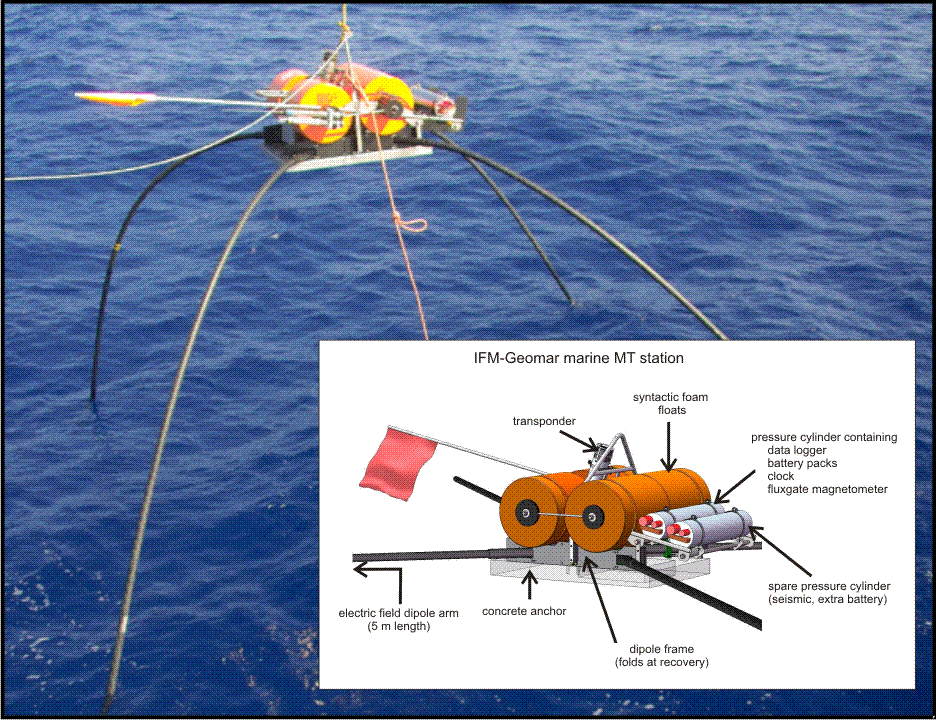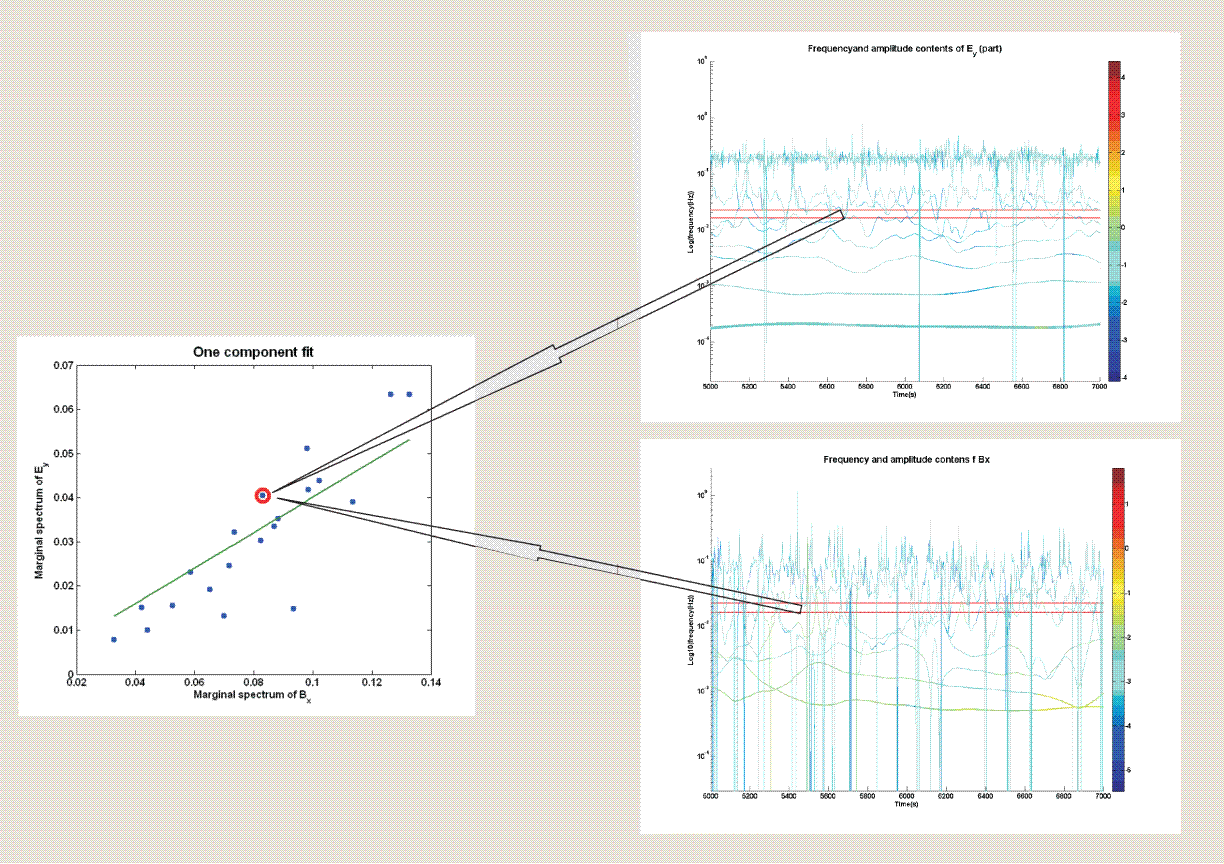 Web Content Display Web Content Display
WHY marine Magnetotellurics (MT) in the SFB 574? The electrical conductivity is most sensitive to the presence of fluids in the host rock and may change over orders of magnitude depending on water content, presence of partial melt and connectivity. Electromagnetic (EM) experiments, as f.ex. Magnetotellurics (MT), measuring the electrical resistivity distribution are therefore a method of choice for imaging water and partial melt distributions. While Germany has a great expertise in land EM, we are building up, within the framework of the SFB, the first German marine EM group. The work of the group thus encompasses design and construction of marine EM instrument, data acquisition, data processing as well as data interpretation modules.
Marine EM Instruments We constructed highly sensitive marine MT Stations (figure 1) within the SFB574 together with the KUM Technologies, Kiel and Magson GmbH, Berlin. The stations are free falling and measure electric and magnetic field variations and tilt variations on the seafloor for a duration of up to 6 months. From the time series we may deduce magnetotelluric responses in a period range from 0.1s to several days which may give information of resistivity structure from a depth of several kilometres down to hundreds of kilometres.
Data acquisition The MT stations were used in 2007-2008 to conduct a long-period offshore magnetotelluric investigation in north western Costa Rica, where the Cocos Plate subducts beneath the Caribbean plate. Eleven marine magnetotelluric Stations were deployed on the 200 km long marine profile for several months, which is an extension of a land profile carried out by the Free University of Berlin over length of 160 km with further 18 stations. The MT data set revealed a number of interesting features imaging the Hydration and Dehydration of the Costa Rican Subduction Zone which are discussed below.
Data processing Data processing of marine MT data is very challenging due to the fact that tidal current and waves may shake the stations intermittently (especially for shallow water and continental shelf data). We are therefore working on developing new MT data processing techniques that incorporate tilt measurements and allows us to work in the time as well as spectral domain. For the latter we are using Hilbert Huang transforms and Empirical Mode Decomposition which allow a representation of the electric and magnetic data in time and frequency and furthermore a magnetotelluric response function determination (figure 2).
Data interpretation: The Amphibious MT profile across the Costa Rican subduction zone and pseudosections of the TE and TM mode MT responses are shown in figure 3. These responses depict the subduction zone highlighted through electrical current along and across strike respectively and are to be understood as a strongly smoothed indication of resistivity variations with increasing depth (corresponding to increasing periods). While the amphibious data is consistent within each mode, the difference between the two modes show that the underlying resistivity distribution is highly two dimensional. We are currently inverting the amphibious responses to an electrical resistivity model.
Figure 1: IFM-Geomar marine MT station
Figure 2: Right side: Hilbert spectra (frequency versus time) of electric and magnetic field data measured at the seafloor. Left side: Derivation of MT response function through linear fit of electric and magnetic field amplitudes pairs within a frequency band at different times.
Figure 3: Upper panel: Layout of amphibious MT profile. Bottom panels: MT response (apparent resistivity) along profile as function of period for the TE mode and TM mode (corresponding to currents flowing along and perpendicular to strike).
SFB Junior Research Group Members: Junior Research Group Leader: Dr. Marion Jegen-Kulcsar PhD Students: Tamara Worzewski (Costa Rica Experiment) Jin Chen (Data Processing)
Publications: 2009 Worzewski, T., M. Jegen-Kulcsar, H. Brasse, W. Taylor, 2009. Amphibious MT Experiment on Costa Rican subduction zone to investigate deep electrical resistivity structure, International Association of Geomagnetism and Aeronomy Scientific Assembly, Soprun, Hungary, 23th to 30th August. Avdeeva A., R. Gehrmann, M. Jegen, 2009. Salt dome overhang detectability study for marine magnetotelluric method, International Association of Geomagnetism and Aeronomy Scientific Assembly, Soprun, Hungary, 23th to 30th August. Neska, A., Nowozynski K., Fox Maule C., Worzewski T., 2009. Improving magnetotelluric transfer functions quality by including known disturbing signals to the processing. International Association of Geomagnetism and Aeronomy Scientific Assembly, Soprun, Hungary, 23th to 30th August. Worzewski, T., M. Jegen-Kulcsar, H. Brasse, W. Taylor, 2009. Deep electrical resistivity structure of the Costa Rican Subduction Zone, European Geosciences Union General Assembly, Vienna, Austria, 19th to 24th April. Hoelz , S., M. Jegen, 2009. Development of a CSEM system for the electromagnetic investigation of the North Alex Mud Volcano, European Geosciences Union General Assembly, Vienna, Austria, 19th to 24th April. S. Kutterolf, A. Freundt, T. Kwasnitschka, M. Jegen, H.-F. Graf, W. Perez, and H.-U. Schmincke, 2009. Cyclic volcanism at convergent margins: Controlled by global climate changes?. European Geosciences Union General Assembly, Vienna, Austria, 19th to 24th April (solicited). Chen, J. and M. Jegen-Kulcsar , Empirical Mode Decomposition and Hilbert Spectra in MT data processing, 2009. European Geosciences Union General Assembly, Vienna, Austria, 19th to 24th April. Gehrmann, R., A. Avdeeva, J. Bialas, S. Hoelz, M. Jegen, M. Lefeldt, M. Sommer und T. Worzewski, 2009. Magnetotellurische und reflexionsseismische Daten im Umfeld des Schlammvulkans North Alex, West Nil Delta – erste Ergebnisse., Jahrestagung der Deutschen Geophysikalischen Gesellschaft, Kiel, Germany, March 23rd to 26th. Hoelz, S. and M. Jegen 2009. Erste Ergebnisse eines CSEM Experiment auf dem Schlammvulkan North Alex im suedoestlichen Mittelmeer. Jahrestagung der Deutschen Geophysikalischen Gesellschaft, Kiel, Germany, March 23rd to 26th. Schwalenberg, K., Haeckel, M., Poort, J. and Jegen-Kulcsar, M., 2009: Evaluation of gas hydrate deposits in an active seep using marine controlled source electromagnetics; results from Opouawe Bank, Hikurangi Margin, New Zealand. Marine Geology, 2009, OnlineFirst. doi:10.1016/j.margeo.2009.07.006 Brasse, H., Kapinos, G., Mütschard, L., Alvarado, G.E., Worzewski, T. and Jegen-Kulcsar, M., 2009: Deep electrical resitivity structure of northwestern Costa Rica. Geophysical Research Letters, 36, L02310. doi:10.1029/2008GL036397 Jegen-Kulcsar, M., Hobbs, R.W., Tarits, P. and Chave, A., 2009: Joint inversion of marine magnetotelluric and gravity data incorporating seismic constraints: preliminary results of sub-basalt imaging off the Faroe Shelf. Earth and Planetary Science Letters, 282, 47-55. doi:10.1016/j.epsl.2009.02.018
2008 Chen, J. and Jegen-Kulcsar, M., 2008: Empirical model decomposition and Hilbert Hunag Transform (HHT) in MT data processing. 19. International Workshop on EM Induction in the Earth, Beijing, China, 23.10.-29.10.2008. Schwalenberg, K., Jegen-Kulcsar, M. and Keen, G., 2008: Marine controlled source electromagnetics on the Hikurangi Margin, NZ: coincidence between cold gas seep sites and electrical resistivity anomalies indicating sub-seafloor gas hydrate deposits. 6th International Conference of Gas Hydrates 2008, Vancouver, British Columbia, Canada, 0610.-10.07.2008 Schwalenberg, K., Netzeband, G., Poort, J. and Jegen-Kulcsar, M., 2008: Geophysical implications of submarine gas seeps on the Hikurangi Margin, NZ. EGU General Assembly, Vienna, Austria, 13.04.-18.04.2008. Brasse, H., Kapinos, G., Mütschard, L., Alvarado, G.E.,Worzewski, T. and Jegen-Kulcsar, M., 2008: First deep resistivity section of Costa Rica. 19. International Workshop on EM Induction in the Earth, Beijing, China, 23.10.-29.10.2008. Hölz, S.and Jegen-Kulcsar, M., 2008: Preparative model-study for a CSEM-experiment at the North Alex Mud Volcano. 9th ICSG-Meeting, Bremen, 15.09.-19.09.2008. Moorkamp, M., Chen, J., Heincke, B., Jegen-Kulcsar, M., Hobbs, R. and Henderson, D., 2008: Joint inversion of MT, gravity and seismic data applied to sub-basalt imaging. 19. International Workshop on EM Induction in the Earth, Beijing, China, 23.10.-29.10.2008 Worzewski, T., Jegen-Kulcsar, M., Chen, J., Hölz, S., Moorkamp,M. and Brasse, H.: Marine Magnetotellurics on Costa Rican Subduction zone. IAGA WG 1.2 on Electromagnetic Induction in the Earth (19th EM Induction Workshop), Beijin, China, October 23-29, 2008
2007 Hobbs, R.W., Jegen-Kulcsar, M., Chen, J. and Heincke, B., 2007: Joint Inversion applied to data from the Faroe-Shetland Trough. EAGE, London, Great Britain (solicited). Chen, J., Jegen-Kulcsar, M. and Heincke, B., 2007: Joint Inversion and Topographic Correction of Geophysical Data. 20th Colloquium of Latin-American Earth Sciences, DFG, Kiel, 10.04.-13.04.2007. Bialas, J., Greinert, J., Barnes, P., Henrys, S., Jegen-Kulcsar, M., Klaucke, I., Krabbenhöft, A., Netzeband, G., Pecher, I. and Petersen, J., 2007: Cold vents and gas hydrates - first results from the cruise SO 191-1 to the Hikurangi Plateau offshore New Zealand. European Geosciences Union General Assembly, Vienna, Austria, 18.04.2007. Schwalenberg, K., Scholl, C., Willoughby, E., Edwards, R.N., Jegen-Kulcsar, M., Caldwell, G. and Keen, D., 2007: Marine CSEM Using a Bottom -Towed System to Explore Submarine Cold Vent Sites in Cascadia and New Zealand. IUGG 24th General Assembly 2007, Pergugia, Italy, 02.-13.07.2007. Worzewski, T., Jegen-Kulcsar, M. and Franke, A., 2007: Planning a Marine MT Experiment On a subduction zone. US-MARGINS/SFB574 Workshop to integrate Subduction Factory and Seismogenic Zone Studies in Central America, San Jose, Costa Rica, June 18-22, 2007. Worzewski, T., Jegen-Kulcsar, M. and Franke, A., 2007: Marine MT Experiment on Subduction Zones, 20th Colloquium on Latin American Earth Sciences in Kiel, Germany, 10.-13-April 2007.
2006 Jegen-Kulcsar, M., 2006: Concept of Joint Inversion. Joint Inversion Workshop, SEG, New Orleans, USA (solicited). Jegen-Kulcsar, M., 2006: Joint Inversion, the Way Forward. 2nd Faeroese Sub basalt Imaging Conference, Torshavn, Faeroe Islands (solicited). Heincke, B., Jegen-Kulcsar, M., Chen, J. and Hobbs, R.W., 2006: Joint Inversion of MT, Gravity and Seismic Data applied to sub-basalt Imaging. SEG, New Orleans, USA (eingeladener Vortrag). Heincke, B., Jegen-Kulcsar, M. and Hobbs, R.W., 2006: Joint Inversion von seismischen Tomografie-, MT- und Gravimetriedaten zur Bestimmung von Strukturen unterhalb von Basaltschichten. DGG, Bremen (solicited). Jegen-Kulcsar, M., 2007: Marine Elektromagnetik. Kolloquium, Universität Hamburg, Hamburg, 29.11.2007 (Vortrag). Jegen-Kulcsar, M., 2008: Marine Elektromagnetik in der Wissenschaft und Industrie. Kolloquium, FU Berlin, Berlin, 22.05.2008 (Vortrag). Jegen-Kulcsar, M. & Hobbs, R.W 2005. Outline of a Joint Inversion of Gravity, MT and Seismic Data. Ann. Soc. Sci. Faeroensis 43: 163-167. Worzewski, T., Jegen-Kulcsar, M. & Franke, A.: Marine MT experiment on a subduction zone - A Feasability Study, 18th EM Induction Workshop in El Vendrell, Spain, 17-23 September, 2006.
Read more: |
 Events Events
Kieler Wissenschaftler fühlen den 'Puls der Erde' Wie funktioniert die Recyclingmaschine der Erde?Nach elf Jahren endet der Kieler Sonderforschungsbereich 574 zu Subduktionszonen Final colloquium of SFB 574 Teilprojekt ÖffentlichkeitsarbeitMEERESFORSCHUNG FÜR MICH UND DICH |
|
©SFB574 // Wischhofstrasse 1-3 // D-24148 Kiel // T. +49 (0)431 600 1413 // elange [AT] geomar.de








